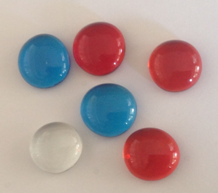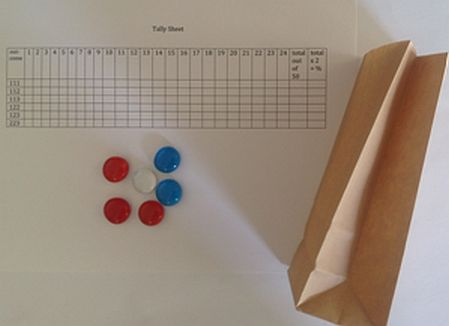1.1. First hands-on activity

Supplies: marbles, a brown paper bag, and a tally sheet
Choose six non-rolling marbles, 3 of one color, 2 of another, and 1 of a third. You have a brown paper bag. Place the marbles in the bag, close it and shake it, and draw out (without looking) three at once. Record the number of each color you got on your score sheet. (Below you can see that there are six possible outcomes.) Put the marbles back in the bag, close it, and shake it. Again draw out three at once without looking, and record the colors. Continue this 50 times. Tally your scores.

1.2. Computing the probability
Suppose you have 6 marbles, 3 red, 2 blue, and 1 clear, in your bag. If you draw out three of the six marbles randomly, what are the chances of getting each of the six combinations?
When we choose three out of six, we need Pascal’s triangle up to six:
1
1 1
1 2 1
1 3 3 1
1 4 6 4 1
1 5 10 10 5 1
1 6 15 20 15 6 1
In order to compute the values of Pascal’s triangle, use the nCr notation, which you find on the TI-83/84 under MATH, PROB, 3:nCr. You may read it as, “the number of ways one can choose r items out of a collection of n items”, or simply “n choose r”.
0c0
1c0 1c1
2c0 2c1 2c2
3c0 3c1 3c2 3c3
4c0 4c1 4c2 4c3 4c4
5c0 5c1 5c2 5c3 5c4 5c5
6c0 6c1 6c2 6c3 6c4 6c5 6c6
So, for example, 4c2 = 6 means I can choose 2 items out of a collection of 4 items in 6 different ways.
Let’s check that this is true. Name these four items A, B, C and D. You can choose: A and B, A and C, A and D, B and C, B and D, or C and D. The order in which you choose the items is irrelevant. When choosing A and B you may select first A and then B. or first B and then A, or pick up both at the same time.
List all the ways you can choose three different letters out of A, B, C, D, E and F, in order to show that the total number of ways you can choose 3 objects out of 6 is really 20 (which is written 6c3=20).
There are six different possible outcomes of choosing three marbles out of your bag which contains 6 marbles: R, R, R, B, B, and C. They are RRR, RRB, RRC, RBB, RBC, and BBC. Let’s compute the probabilities of getting each of the six.
red blue clear
RRR: (3c3) * (2c0) * (1c0) = 1*1*1=1 out of 20 = 5%
RRB: (3c2) * (2c1) * (1c0) = 3*2*1=6 out of 20 = 30%
RRC: (3c2) * (2c0) * (1c1) = 3*1*1=3 out of 20 = 15%
RBB: (3c1) * (2c2) * (1c0) = 3*1*1=3 out of 20 = 15%
RBC: (3c1) * (2c1) * (1c1) = 3*2*1=6 out of 20 = 30%
BBC: (3c0) * (2c2) * (1c1) = 1*1*1=1 out of 20 = 5%
20 out of 20 = 100%
Let’s check that the number of ways of choosing two red marbles and one blue marble, RRB, from the bag is 6.
Marbles in the bag: R R R B B C
Choices: R R B
R R B
R R B
R R B
R R B
R R B
(Click image for printable version)
Return to
Drawing Marbles Index